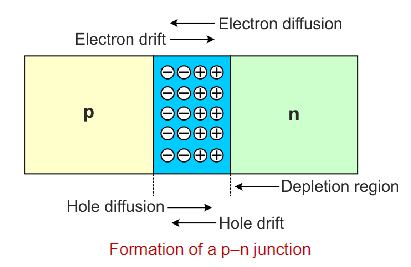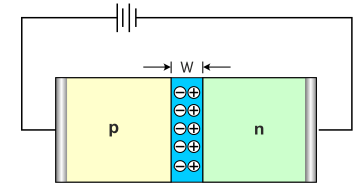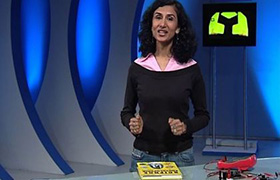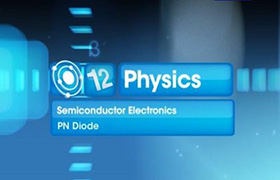CBSE Class 12-science Answered
Explain with the help of a suitable diagram, the two processes which
o
ccur during the formation of a p-n junction diode. Hence define the terms (i)
depletion region and (ii) potential barrier. (b) Draw a circuit diagram of a p-n
j
unction diode under forward bias and explain its working. (5M)
Asked by kabirnarwal0 | 13 Jan, 2024, 13:49: PM
Two important processes that occur during forming a p–n junction are diffusion and drift.
Diffusion:
- During the formation of a p–n junction and due to the concentration gradient across the p and n sides, holes diffuse from the p-side to the n-side (p →n) and electrons diffuse from the n-side to the p-side (n → p). This motion of charge gives rise to a diffusion current across the junction.
- When an electron diffuses from n → p, it leaves behind an ionised donor on the n-side. Similarly, when a hole diffuses from p → n due to the concentration gradient, it leaves behind an ionised acceptor (negative charge) which is immobile.
- Because of these two processes, the positive charge layer forms on the n-side and the negative charge layer forms on the p-side which together form the depletion region.
Drift:
- Because of this region, an electric field from the positive charge to the negative charge is developed which causes a flow of electrons from the p-side to the n-side across the junction.
- This is called the electron drift and the current produced due to this movement is called the drift current. Initially, the diffusion current is large and the drift current is small.
- This process continues until the diffusion current equals the drift current. Thus, a p–n junction is formed. In a p-n junction under equilibrium, there is no net current.
Depletion region:
The depletion layer is the region created around the p-n junction which is devoid of free charge carriers and has immobile ions. It is created due to the diffusion of majority carriers across the junction when the p-n junction is formed.
Potential barrier:
- The loss of electrons from the n-region and the gain of electrons by the p-region cause a difference of potential across the junction of the two regions.
- The polarity of this potential is such as to oppose further flow of carriers so that a condition of equilibrium exists.
- Because this potential tends to prevent the movement of electrons from the n-region to the p-region, it is often called a barrier potential.
p-n junction diode under forward bias:
- When an external voltage V is applied across a semiconductor diode such that the p-side is connected to the positive terminal of the battery and the n-side to the negative terminal, it is said to be forward-biased.
- The applied voltage mostly drops across the depletion region and the voltage drop across the p-side and n-side of the junction is negligible.
- The direction of the applied voltage (V) is opposite to the built-in potential V0. As a result, the depletion layer width decreases and the barrier height is reduced.
- The effective barrier height under forward bias is (V0 − V).
Answered by Shiwani Sawant | 15 Jan, 2024, 10:09: AM
Concept Videos
CBSE 12-science - Physics
Asked by kabirnarwal0 | 13 Jan, 2024, 13:49: PM
CBSE 12-science - Physics
Asked by jagadeviteli1983 | 06 Sep, 2020, 10:27: AM
CBSE 12-science - Physics
Asked by kajalkumari2k15 | 30 Nov, 2019, 11:14: AM
CBSE 12-science - Physics
Asked by Topperlearning User | 18 Jun, 2014, 10:42: AM
CBSE 12-science - Physics
Asked by Topperlearning User | 18 Jun, 2014, 10:48: AM
CBSE 12-science - Physics
Asked by Topperlearning User | 18 Jun, 2014, 10:52: AM
CBSE 12-science - Physics
Asked by Topperlearning User | 18 Jun, 2014, 11:05: AM
CBSE 12-science - Physics
Asked by Topperlearning User | 18 Jun, 2014, 11:15: AM
CBSE 12-science - Physics
Asked by Topperlearning User | 18 Jun, 2014, 11:21: AM
CBSE 12-science - Physics
Asked by Topperlearning User | 04 Jun, 2014, 13:23: PM






